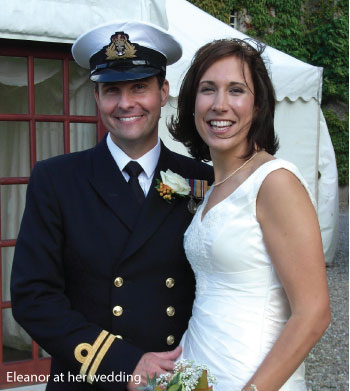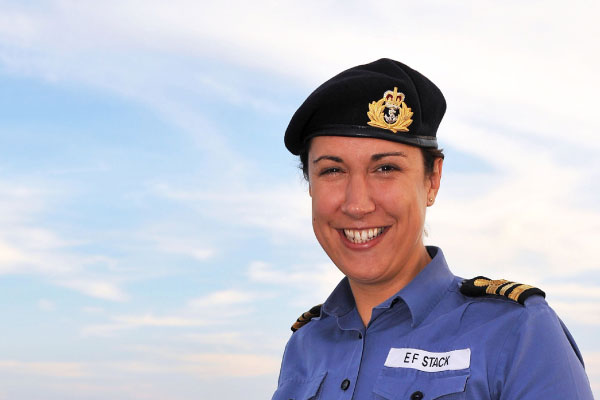The sea was the last bastion conquered by women in the armed forces worldwide. Royal Navy’s Lieutenant Commander Eleanor Stack gives us a peek into life inside a frontline warship.
Thirty-five-year old Lieutenant Commander Eleanor Stack runs a tight ship. Standing tall at 6’2”, this lady from Glasgow is in charge of the minehunter HMS Quorn, commanding a crew of 45 men, which includes clearance divers who identify and diffuse mines under the sea.
Eleanor, or Ellie as she’s known to colleagues, joined the Royal Navy as a Warfare Officer in 2000. In course of her 13-year career, she served on warships around the world in various roles until she was elevated to the rank of Commanding Officer earlier this year. Ellie tells us about life at sea, its challenges and the rewards.
Woman This Month (WTM): What made you embark on this career path?
Eleanor Stack (ES): Around the age of 14, I’d gone on a school trip to the Glasgow shipyard. My hometown has a great tradition of ship building and what I saw on my visit seemed quite challenging. Besides, I’d always had a close affinity to the sea. I spent my childhood swimming off the Scottish Islands, sailing with my father and fishing with my family.
 WTM: How did your family react with your decision?
WTM: How did your family react with your decision?
ES: With surprise. I’m the youngest in a family of academics and up until the night before my admiralty board interview, my family doubted that I was serious about sailing. When we were training in Glasgow on my previous ship, I had the opportunity to bring my family on board for the first time and they loved it. It’s quite difficult to articulate to people, especially family and friends, what it is you do as a sailor and what it’s like to live and work on a warship.
WTM: What does the HMS Quorn do?
ES: Basically, the Royal Navy is in the Gulf to protect and support freedom of navigation. My specialisation is mine warfare and the HMS Quorn is part of the four minehunters from the UK. We survey routes, identify potentially hazardous objects and if necessary, destroy them to ensure that anyone using the sea can do so safely.
WTM: What are the top qualities you look for in your sailors?
ES: Sailing involves being away from home and loved ones for months at a time. Add to that the fact that warships are not the most comfortable places to live in. So it’s very important for a sailor to have a sense of humour, and the stamina and determination to get on with the job and do what they’re asked to do. Their attitude should be such that they can motivate other people as well.
WTM: What’s been the highlight of your career so far?
ES: It is when I was made Commanding Officer earlier in April this year. Being in command is definitely the most challenging because when anyone talks about the HMS Quorn, they’re essentially talking about me.
I’m answerable for anything that goes wrong here and likewise, when it goes well, it is
very rewarding.
WTM: Have you ever thought of yourself as a woman in a man’s territory?
ES: Not really. However, I’m conscious of the fact that I’m the only woman on board my ship. But it doesn’t matter as long as I can do the job because that’s all sailors care about on a ship — whether you can do the job.
WTM: When was the closest you came to danger on an assignment?
ES: That would be Operation Highbrow in 2006, when as Navigating Officer aboard the HMS York, we sailed into Beirut multiple times to evacuate hundreds of civilians from war-torn Lebanon. Operating in a conflict zone was tremendously challenging, but being able to rescue people was the reward. After all, that’s what we’re trained for.
 WTM: How do you keep fit on a ship?
WTM: How do you keep fit on a ship?
ES: With difficulty. The ship is small and we don’t have extensive fitness equipment. We train on a couple of rowing machines, cross trainers, static cross fits and use skipping ropes. I like running. Whenever we’re at a port, we like to do sports. In Bahrain, we play at the Rugby Club and are currently training for the Bahrain Half Marathon.
WTM: How difficult is it juggling personal life with your career?
ES: I’d met my husband before joining the Navy, so we knew it would be difficult. It’s hard to be away from family, sometimes for six months or longer. But when you’re both doing something you enjoy and something you both understand, then that makes it easier. Most of my crew have very supportive families and that’s the only way you can do the job sometimes. Keeping in touch is easy when you have Skype, email and so on.
WTM: What’s your ultimate ambition?
ES: I want to do as well as I can in my profession. The Navy has supported me in everything I’ve done. They’ve given me fantastic opportunities to do assignments, to travel to parts of the world I’d never thought possible and to meet fascinating people. I want to keep doing everything they ask me to.
On the personal front, I’m lucky to have a fantastic husband, great family and friends. I’ll try and see as much of them as possible! I’m a very social person and I play a lot of sports. Trying to cram everything and keep the work life balanced is the biggest challenge.
WTM: What does it take for a woman to break the glass ceiling in the armed forces?
ES: Actually women have conquered almost every front in the Royal Navy. They work as mine clearance divers and even submarines are now open to them. There’s very little that we’re barred from doing anymore. g


































